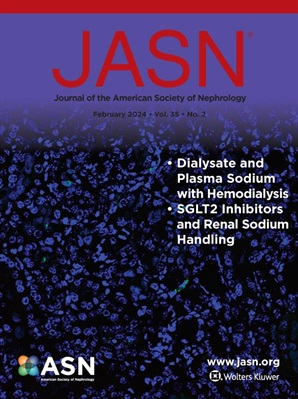Proteomic Assessment of the Risk of Secondary Cardiovascular Events among Individuals with CKD.
IF 10.3
1区 医学
Q1 UROLOGY & NEPHROLOGY
引用次数: 0
Abstract
BACKGROUND Cardiovascular risk models have been developed primarily for incident events. Well-performing models are lacking to predict secondary cardiovascular events among people with a history of coronary heart disease, stroke, or heart failure who also have chronic kidney disease (CKD). We sought to develop a proteomics-based risk score for cardiovascular events in individuals with CKD and a history of cardiovascular disease. METHODS We measured 4638 plasma proteins among 1067 participants from the Chronic Renal Insufficiency Cohort (CRIC) and 536 individuals from the Atherosclerosis Risk in Communities Cohort (ARIC). All had non-dialysis-dependent CKD and coronary heart disease, heart failure, or stroke at study baseline. A proteomic risk model for secondary cardiovascular events was derived by elastic net regression in CRIC, validated in ARIC, and compared to clinical models. Biologic mechanisms of secondary events were characterized through proteomic pathway analysis. RESULTS A 16-protein risk model was superior to the Framingham risk score for secondary events, including a modified score that included estimated glomerular filtration rate (eGFR). In CRIC, the annualized area under the receiver operating characteristic (AUC) within 1 to 5 years ranged between 0.77 and 0.80 for the protein model and 0.57 and 0.72 for the clinical models. These findings were replicated in the ARIC validation cohort. Biologic pathway analysis identified pathways and proteins for cardiac remodeling and fibrosis, vascular disease, and thrombosis. CONCLUSIONS The proteomic risk model for secondary cardiovascular events outperformed clinical models based on traditional risk factors and eGFR.对慢性肾脏病患者继发性心血管事件风险的蛋白质组学评估
背景心血管风险模型主要是针对突发事件而开发的。对于有冠心病、中风或心力衰竭病史且同时患有慢性肾脏病(CKD)的人,目前还缺乏性能良好的模型来预测继发性心血管事件。我们对慢性肾功能不全队列(CRIC)的 1067 名参与者和社区动脉粥样硬化风险队列(ARIC)的 536 名参与者的 4638 种血浆蛋白质进行了测量。这些人在研究基线时均患有非透析依赖型慢性肾脏病和冠心病、心力衰竭或中风。在 CRIC 中通过弹性净回归得出了继发性心血管事件的蛋白质组风险模型,在 ARIC 中进行了验证,并与临床模型进行了比较。结果在继发性心血管事件方面,16 种蛋白风险模型优于弗明翰风险评分,包括包括估计肾小球滤过率 (eGFR) 的修改评分。在 CRIC 中,蛋白质模型在 1 至 5 年内的年化接收器操作特征下面积(AUC)介于 0.77 和 0.80 之间,临床模型介于 0.57 和 0.72 之间。这些结果在ARIC验证队列中得到了重复。结论:继发性心血管事件的蛋白质组风险模型优于基于传统风险因素和 eGFR 的临床模型。
本文章由计算机程序翻译,如有差异,请以英文原文为准。
求助全文
约1分钟内获得全文
求助全文
来源期刊
CiteScore
22.40
自引率
2.90%
发文量
492
审稿时长
3-8 weeks
期刊介绍:
The Journal of the American Society of Nephrology (JASN) stands as the preeminent kidney journal globally, offering an exceptional synthesis of cutting-edge basic research, clinical epidemiology, meta-analysis, and relevant editorial content. Representing a comprehensive resource, JASN encompasses clinical research, editorials distilling key findings, perspectives, and timely reviews.
Editorials are skillfully crafted to elucidate the essential insights of the parent article, while JASN actively encourages the submission of Letters to the Editor discussing recently published articles. The reviews featured in JASN are consistently erudite and comprehensive, providing thorough coverage of respective fields. Since its inception in July 1990, JASN has been a monthly publication.
JASN publishes original research reports and editorial content across a spectrum of basic and clinical science relevant to the broad discipline of nephrology. Topics covered include renal cell biology, developmental biology of the kidney, genetics of kidney disease, cell and transport physiology, hemodynamics and vascular regulation, mechanisms of blood pressure regulation, renal immunology, kidney pathology, pathophysiology of kidney diseases, nephrolithiasis, clinical nephrology (including dialysis and transplantation), and hypertension. Furthermore, articles addressing healthcare policy and care delivery issues relevant to nephrology are warmly welcomed.

 求助内容:
求助内容: 应助结果提醒方式:
应助结果提醒方式:


